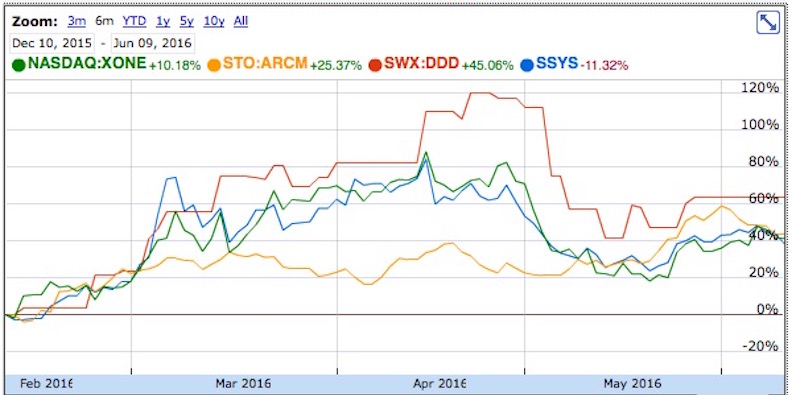
There’s been so much doom and gloom regarding 3D print stocks in the past two years it’s hard to see any light. But perhaps there is.
If you owned stock in virtually any 3D print-related company in the period of 2010-2014, you’d have been very happy. The stock prices rose ridiculously, sometimes as much as 10X their previous value.
This happened largely because the public “discovered” 3D printing, even though it had been in strong existence for more than 25 years earlier. The reason for this discovery was that certain initial patents had expired, opening the possibility for entrepreneurs to develop low cost 3D printers using that technology.
Low cost: meaning something actual consumers could consider buying.
And that’s the strategy that several companies, most notably MakerBot and 3D Systems pursued. Their highly public efforts dramatically raised the awareness of the technology among many members of the public.
That same interest drove up the stock prices as many people “got on the bandwagon” and bought stock without truly understanding what the technology could actually do – or not do.
Unfortunately, their mistaken faith in the technology was short-lived, as it eventually became clear that 3D printing technology, although quite amazing, was not something yet ready for the general consumer. Consumers who did attempt to use 3D printing very often had issues, resulting in a general disappointment in the technology.
The stock prices subsequently fell quite dramatically, ironically back to levels seen before the big raise.
This financial shock has shaken the 3D printing industry quite profoundly. Today we see virtually every company changing their strategy to focus not on consumers, who really had no practical possibility of widespread use of 3D printing, instead towards professionals, designers, industry, manufacturers and others who can truly make excellent use of 3D printing technology.
Focus on the uses that make sense. Not the ones that are buzz worthy.
That change, currently sweeping 3D printing companies, has manifested in strategic shifts by most. Several companies have made significant changes in their executive leadership in the past six months.
It’s all good news for 3D printing technologies. But has this reflected in a change in stock values?
Usually such changes take considerable time to soak into the investment community, but now, half-way through 2016, we should take a look.
At the top I’ve placed an image of the stock price changes for the leading publicly traded 3D printing companies: Stratasys, 3D Systems, XOne, and Arcam. From February of this year, we see a stumbling improvement. There’s ups and downs to be sure, as one might expect in a stock market, but the trend is clear: these companies are recovering their value, at least in the public eye, by tweaking their strategies and management.

